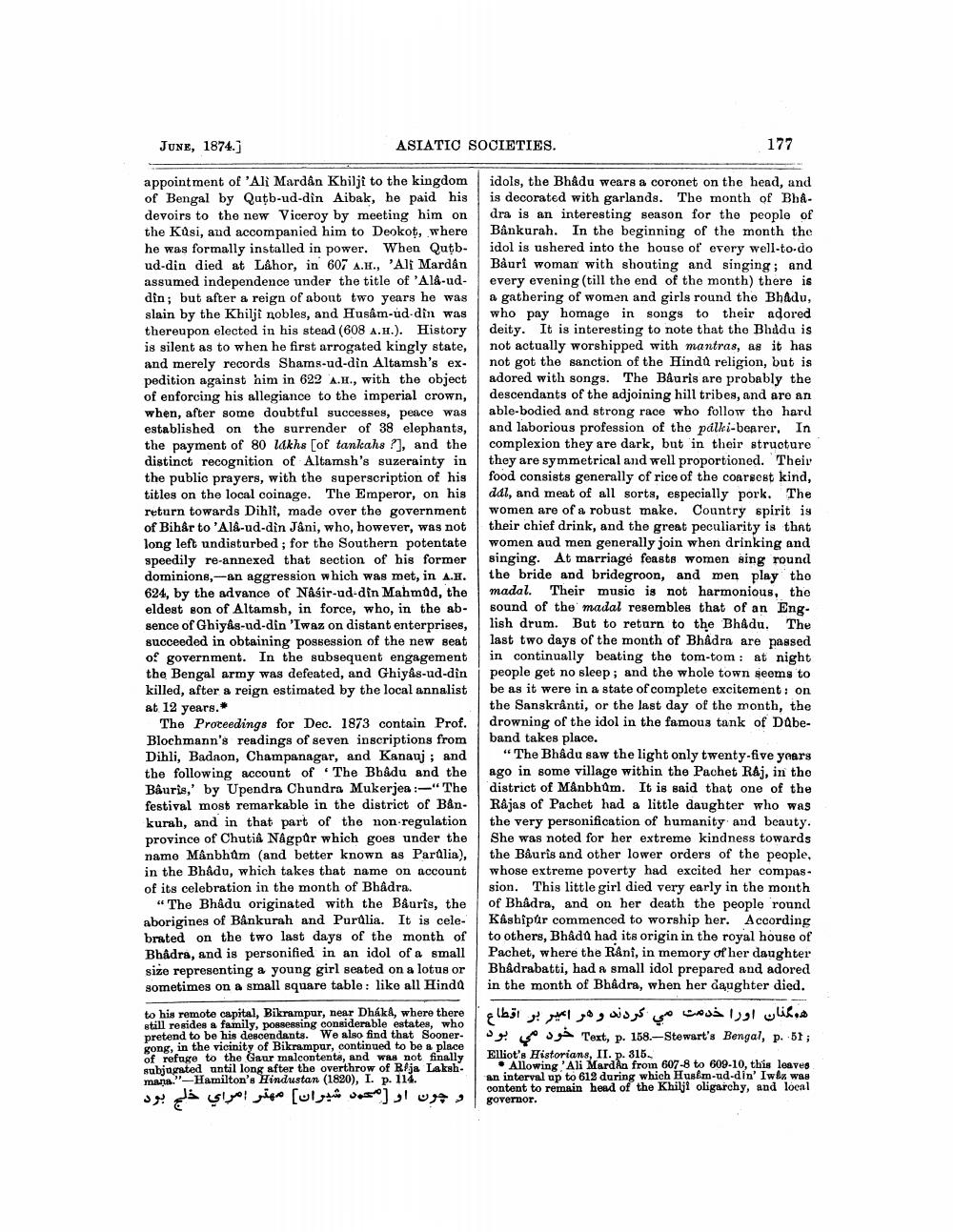________________
JUNE, 1874.
ASIATIC SOCIETIES.
177
appointment of 'Ali Mardân Khiljt to the kingdom of Bengal by Qutb-ud-din Aibak, he paid his devoirs to the new Viceroy by meeting him on the Kusi, and accompanied him to Deokoț, where he was formally installed in power. When Qutbud-din died at Láhor, in 607 A.H., 'Ali Mardan assumed independence under the title of 'Al&-uddin; but after a reign of about two years he was slain by the Khilji nobles, and Husâm-ud-din was thereupon elected in his stead (608 A.H.). History is silent as to when he first arrogated kingly state, and merely records Shams-ud-din Altamsh's expedition against him in 622 A.H., with the object of enforcing his allegiance to the imperial crown, when, after some doubtful successes, peace was established on the surrender of 38 elephants, the payment of 80 lakhs [of tankahs ?], and the distinct recognition of Altamsh's suzerainty in the public prayers, with the superscription of his titles on the local coinage. The Emperor, on his return towards Dihli, made over the government of Bihår to 'Ald-ud-din Jåni, who, however, was not long left undisturbed; for the Southern potentate speedily re-annexed that section of his former dominions,--an aggression which was met, in A.H. 624, by the advance of Nasir-ud-din Mahmud, the eldest son of Altamsh, in force, who, in the abgence of Ghiyas-ud-din 'Iwaz on distant enterprises, succeeded in obtaining possession of the new seat of government. In the subsequent engagement the Bengal army was defeated, and Ghiyas-ud-din killed, after a reign estimated by the local annalist at 12 years.*
The Proceedings for Dec. 1873 contain Prof. Blochmann's readings of seven inscriptions from Dihli, Badoon, Champanagar, and Kanauj; and the following account of The Bbådu and the B&uris,' by Upendra Chundra Mukerjea :-"The festival most remarkable in the district of Ban. kurah, and in that part of the non-regulation province of Chutia Nagpur which goes under the namo Manbham (and better known as Paralia), in the Bhadu, which takes that name on account of its celebration in the month of Bhadra.
"The Bhadu originated with the Bauris, the aborigines of Bankurah and Puralia. It is celebrated on the two last days of the month of Bhadra, and is personified in an idol of a small size representing a young girl seated on a lotus or sometimes on a small square table: like all Hindd
idols, the Bhadu wears a coronet on the head, and is decorated with garlands. The month of BhAdra is an interesting season for the people of Bankurah. In the beginning of the month the idol is ushered into the house of every well-to-do Båuri woman with shouting and singing; and every evening (till the end of the month) there is a gathering of women and girls round the Bhadu, who pay homage in songs to their adored deity. It is interesting to note that the Bhadu is not actually worshipped with mantras, as it has not got the sanction of the Hindu religion, but is adored with songs. The Bauris are probably the descendants of the adjoining hill tribes, and are an able-bodied and strong race who follow the hard and laborious profession of the pálki-bearer, In complexion they are dark, but in their structure they are symmetrical and well proportioned. Theiv food consists generally of rice of the coarsest kind, dal, and meat of all sorts, especially pork. The women are of a robust make. Country spirit is their chief drink, and the great peculiarity is that women aud men generally join when drinking and singing. At marriage feasts women sing round the bride and bridegroon, and men play tho madal. Their music is not harmonious, the sound of the madal resembles that of an English drum. But to return to the Bh&du. The last two days of the month of Bhadra are passed in continually beating the tom-tom: at night people get no sleep; and the whole town seems to be as it were in a state of complete excitement : on the Sanskrånti, or the last day of the month, the drowning of the idol in the famous tank of Dabeband takes place.
"The Bhadu saw the light only twenty-five years ago in some village within the Pachet Ráj, in the district of Månbhum. It is said that one of the Rajas of Pachet had a little daughter who was the very personification of humanity and beauty. She was noted for her extreme kindness towards the Bauris and other lower orders of the people, whose extreme poverty had excited her compas. sion. This little girl died very early in the month of Bhadra, and on her death the people round Kashipur commenced to worship her. According to others, Bhådd had its origin in the royal house of Pachet, where the Râni, in memory of her daughter Bhadrabatti, had a small idol prepared and adored in the month of Bhadra, when her daughter died.
هومنان او را خدمت می کردند و هر امیر بر اقطاع
to his remote capital, Bikrampur, near DhákAwhere there still resides a family, possessing considerable estates, who pretend to be his descendants. We also find that Soonergong, in the vicinity of Bikrampur, continued to be a place of rofage to the Gaur malcontents, and was not finally subjugated until long after the overthrow of Rlja Laksh mana."-Hamilton's Hindustan (1820), I. p. 114.
Sys T ext, p. 158.-Stewart's Bengal, p. 51; Elliot's Historians, II. p. 315.
• Allowing 'Ali MardAn from 607-8 to 609-10, this leaves an interval up to 612 during which Husm-ud-din' Iwz was content to remain head of the Khilji oligarchy, and local governor.
خلي بود
و چون او [محمود شیران] مهتر امراي




